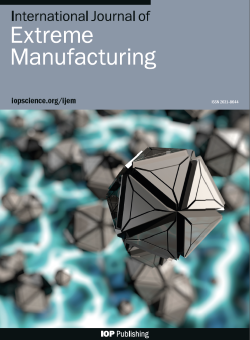Correlative spatter and vapour depression dynamics during laser powder bed fusion of an Al-Fe-Zr alloy
IF 16.1
1区 工程技术
Q1 ENGINEERING, MANUFACTURING
引用次数: 0
Abstract
Spatter during laser powder bed fusion (LPBF) can induce surface defects, impacting the fatigue performance of the fabricated components. Here, we reveal and explain the links between vapour depression shape and spatter dynamics during LPBF of an Al-Fe-Zr aluminium alloy using high-speed synchrotron X-ray imaging. We quantify the number, trajectory angle, velocity, and kinetic energy of the spatter as a function of vapour depression zone/keyhole morphology under industry-relevant processing conditions. The depression zone/keyhole morphology was found to influence the spatter ejection angle in keyhole versus conduction melting modes: (i) the vapour-pressure driven plume in conduction mode with a quasi-semi-circular depression zone leads to backward spatter whereas (ii) the keyhole rear wall redirects the gas/vapour flow to cause vertical spatter ejection and rear rim droplet spatter. Increasing the opening of the keyhole or vapour depression zone can reduce entrainment of solid spatter. We discover a spatter-induced crater mechanism in which small spatter particles are accelerated towards the powder bed after laser-spatter interaction, inducing powder denudation and cavities on the printed surface. By quantifying these laser-spatter interactions, we suggest a printing strategy for minimising defects and improving the surface quality of LPBF parts.Al-Fe-Zr 合金激光粉末床熔融过程中的相关喷溅和蒸汽郁积动力学
激光粉末床熔融(LPBF)过程中产生的飞溅物会诱发表面缺陷,影响制造部件的疲劳性能。在此,我们利用高速同步辐射 X 射线成像技术揭示并解释了 Al-Fe-Zr 铝合金 LPBF 过程中蒸汽凹陷形状与飞溅动态之间的联系。在工业相关加工条件下,我们将飞溅物的数量、轨迹角、速度和动能量化为蒸汽凹陷区/键孔形态的函数。研究发现,在键孔熔化模式和传导熔化模式下,凹陷区/键孔形态会影响喷溅物的喷射角度:(i) 在传导模式下,蒸汽压力驱动的羽流具有准半圆形凹陷区,会导致后向喷溅,而(ii) 键孔后壁会重新定向气体/蒸汽流,导致垂直喷溅物喷射和后缘液滴喷溅。增大钥匙孔或蒸汽凹陷区的开口可减少固体飞溅物的夹带。我们发现了一种溅射诱发凹坑的机制,在这种机制中,激光与溅射相互作用后,小的溅射颗粒会被加速冲向粉末床,导致粉末脱落,并在印刷表面形成凹坑。通过量化这些激光与飞溅物的相互作用,我们提出了一种印刷策略,以尽量减少缺陷并提高 LPBF 零件的表面质量。
本文章由计算机程序翻译,如有差异,请以英文原文为准。
求助全文
约1分钟内获得全文
求助全文
来源期刊

International Journal of Extreme Manufacturing
Engineering-Industrial and Manufacturing Engineering
CiteScore
17.70
自引率
6.10%
发文量
83
审稿时长
12 weeks
期刊介绍:
The International Journal of Extreme Manufacturing (IJEM) focuses on publishing original articles and reviews related to the science and technology of manufacturing functional devices and systems with extreme dimensions and/or extreme functionalities. The journal covers a wide range of topics, from fundamental science to cutting-edge technologies that push the boundaries of currently known theories, methods, scales, environments, and performance. Extreme manufacturing encompasses various aspects such as manufacturing with extremely high energy density, ultrahigh precision, extremely small spatial and temporal scales, extremely intensive fields, and giant systems with extreme complexity and several factors. It encompasses multiple disciplines, including machinery, materials, optics, physics, chemistry, mechanics, and mathematics. The journal is interested in theories, processes, metrology, characterization, equipment, conditions, and system integration in extreme manufacturing. Additionally, it covers materials, structures, and devices with extreme functionalities.
文献相关原料
| 公司名称 | 产品信息 | 采购帮参考价格 |
|---|
 求助内容:
求助内容: 应助结果提醒方式:
应助结果提醒方式:


